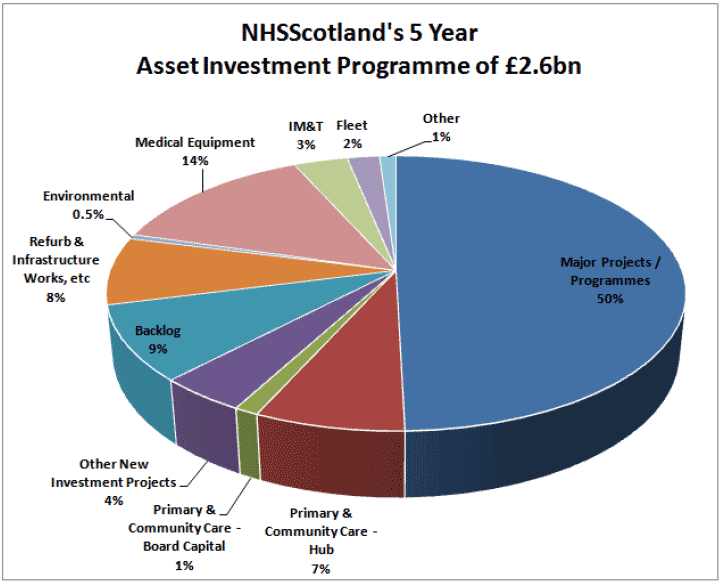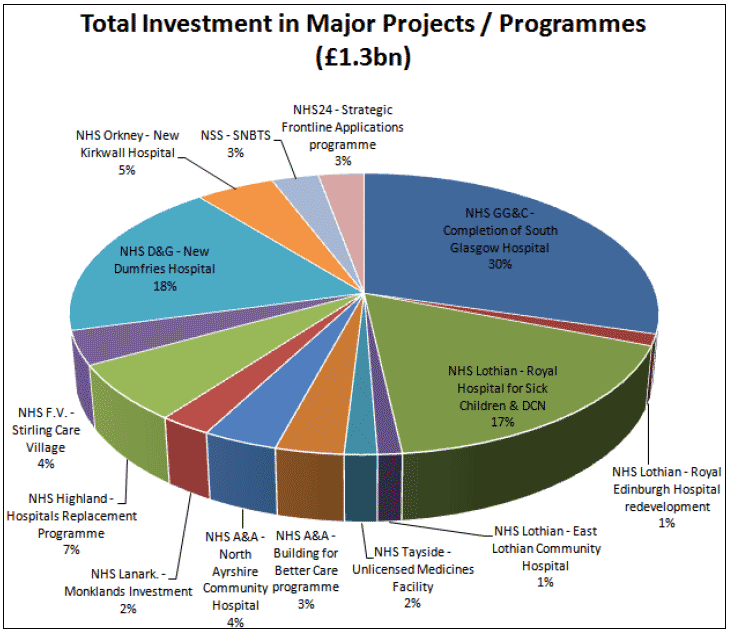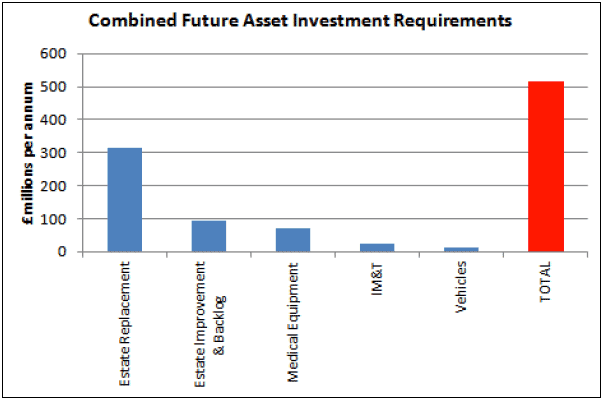Annual State of NHSScotland Assets and Facilities Report for 2013
A review of asset and facilities management performance in NHSScotland, identifying the current state of the estate and facilities management, highlighting areas of best practice and areas for improvement.
4.0 Planned future investment in assets
Planned investment in NHSScotland's assets over the next 5 years is estimated to be circa £2.6bn (based on NHS Boards' 5 year investment plans). This will make a significant contribution to improvements in the condition and performance of these assets. It will also further enhance the important supporting role that assets play in the delivery of quality healthcare delivery. This investment will also enable the disposal of older properties which are expected to generate receipts of approximately £125m over the same period (subject to economic and market conditions).
This investment covers all asset types (property, medical equipment, IM&T, and fleet) and will be achieved through a combination of capital and revenue based investment. It should be noted, however, that some investment categories may overlap; for example, additional Medical Equipment, IM&T and Environmental investment can be incorporated within the other investment categories & projects. The following chart provides a breakdown of this investment.

4.1 Investment in Major Projects / Programmes
Investment in 'Major Projects / Programmes' accounts for 50% of the overall planned future investment described above and includes the key strategic investments planned by each NHS Board. They will be funded mainly though NHS Board capital or NPD revenue based funding. The following chart provides a breakdown of the £1.3bn of investment associated with these major projects / programmes:

4.2 Investment in Primary and Community Care
In addition to the £1.3bn of investment on the major projects / programmes described above, a further £0.33bn is planned for new primary & community care facilities, and other smaller capital replacement schemes. This investment is key to delivering the emerging Health and Social Care Integration agenda and shifting the balance of care from hospitals to local facilities and people's homes.
4.3 Income receipts from asset disposals
A direct consequence of investment in new facilities can often be a surplus of older accommodation no longer required for operational purposes. Planned disposals of these surplus properties is expected to generate income sale receipts of circa £125m over the next 5 years. Scottish Futures Trust is actively supporting NHS Boards to maximise the potential of income receipts from these disposals.
The programme of anticipated income receipts per NHS Board over the next 5 years are listed in the following table, but these are subject to change dependent upon economic and market conditions at the time of sale:
| NHS Board |
Anticipated Income Receipts from Disposals (£m) |
||||
|---|---|---|---|---|---|
| 2013/14 |
2014/15 |
2015/16 |
2016/17 |
2017/18 |
|
| NHS Greater Glasgow & Clyde |
- |
0.3 |
2.6 |
3.8 |
19.5 |
| NHS Lothian |
2.3 |
4.1 |
1.2 |
- |
15.3 |
| NHS Tayside |
1.3 |
6.4 |
5.3 |
- |
- |
| NHS Grampian |
4.9 |
6.0 |
3.2 |
- |
- |
| NHS Fife |
2.2 |
3.8 |
- |
- |
- |
| NHS Ayrshire & Arran |
2.4 |
5.0 |
1.5 |
1.4 |
- |
| NHS Lanarkshire |
1.7 |
4.1 |
3.5 |
1.1 |
- |
| NHS Highland |
2.2 |
1.1 |
5.2 |
2.6 |
4.5 |
| NHS Dumfries & Galloway |
1.0 |
0.1 |
0.3 |
0.2 |
- |
| NHS Borders |
0.4 |
- |
- |
- |
- |
| NHS Western Isles |
0.5 |
0.3 |
- |
- |
- |
| NHS Shetland |
0.3 |
- |
- |
- |
- |
| NHS Orkney |
0.4 |
0.1 |
- |
- |
- |
| NHS National Services Scotland |
- |
- |
- |
- |
4.0 |
| Scottish Ambulance Service |
- |
0.3 |
- |
0.2 |
0.1 |
| TOTAL: |
19.6 |
31.7 |
22.8 |
9.2 |
43.3 |
4.4 Reducing estate backlog through asset investment
Whilst there has been a significant reduction (£152 million) in NHSScotland's base backlog maintenance expenditure requirement since 2011, the level of outstanding backlog of £858 million remains a substantial issue to be addressed and an ongoing estate risk. Boards have estimated (within their PAMS) that their asset investment strategies will reduce their backlog maintenance burden by a further £250m over the next 5 years. This will be achieved through a combination of:
- Estate replacement through capital and revenue funded schemes.
- Estate rationalisation and disposal of older properties brought about by estate replacement, and thus avoiding the need for expenditure on backlog.
- Estate modernisation through refurbishment/upgrading schemes.
- Targeted expenditure of circa £46m per annum on backlog maintenance, particularly focussing on high and significant risk backlog.
Whilst it is essential that high and significant risk backlog is addressed as a matter of priority, it is not practical or affordable to address all backlog over the short term (5 years), hence the need for longer term planning.
4.5 Investment required on vehicle assets
As described earlier in this report, many of the NHSScotland vehicles are leased and, therefore, the replacement cost of these vehicles is effectively included within the annual leasing costs. However, substantial vehicle assets remain owned, particularly those of the Scottish Ambulance Service, NHS National Services Scotland, NHS Tayside, NHS Fife, and NHS Borders. These owned vehicle assets are estimated to have a current day replacement cost of circa £95 million. Fleet managers advise that a realistic replacement programme for these vehicle assets is circa 7 years, which equates to £13.6m per annum. The current 5 year investment plan for vehicle assets, which is taken from NHS Boards' own investment plans, is circa £11m per annum (including £10m per annum for Scottish Ambulance Service vehicles). This creates a potential shortfall of £2.6m that would either need further funding from Boards' unallocated resources or increased use of leased vehicles. Note, however, that earlier analysis of age and condition suggests that current vehicle assets are in reasonable condition and age thus do not suggest a current backlog of investment need.
4.6 Investment required on medical equipment assets
In relation to its overall £760m value, during 2012/13 a total of over £78m was spent on medical equipment, split between replacement £63m (80%) and additional £15m (20%). This is considered a just adequate investment benchmark for equipment replacement as it would theoretically result in complete replacement of all existing equipment within 12 years (most equipment tends to need replacing within 7-15 years). Note though that rapid technological developments in some equipment, including high cost radiotherapy and imaging equipment (CT and MRI), which accounts for over 40% of the total value of medical equipment, reduces the effective lifespan of this equipment to 7 to 10 years.
The following table, which is based on information returned by NHS Boards, provides a further indication of the sufficiency of investment over the next 3 years by comparing each annual 'Anticipated Spend' (based on budget allocations) against the overall value of medical equipment (£760m) to provide an indication of the sufficiency of this investment to replace all medical equipment within a reasonable period.
The second part of this table then looks at 'Required Investment', which is based on projected need rather than budget allocations. This provides a comparable indicator of the replacement period if this level of funding was made available.
| Year |
Anticipated Investment* |
Average Replacement Period for all Medical Equipment** |
Required Investment |
Average Replacement Period for all Medical Equipment** |
|---|---|---|---|---|
| 2013/14 |
£74m |
12.8 |
£96m |
10 |
| 2014/15 |
£70m |
13.6 |
£79m |
12 |
| 2015/16 |
£69m |
13.8 |
£77m |
12 |
| TOTAL |
£213m |
£252m |
||
| Average |
£71m |
13.4 |
£84m |
11.3 |
* this excludes the 'special' investment anticipated for the new Southern General, Glasgow but does include both capital and revenue funding
** based on replacement investment being 80% of total 'Anticipated Investment', taken from the average of 2012/13 returns
The table highlights that the average 'Anticipated Investment' over the next 3 years would provide an 'Average replacement period for all medical equipment' of 13.4 years, which is within an expected period of 7 - 15 years (dependent upon equipment type).
In comparison, the average 'Required Investment', if provided, would theoretically replace all medical equipment within 11.3 years; 2 year less than the 'Anticipated Investment' levels would achieve. This is an indication of potential funding pressures on medical equipment replacement.
Implications of not replacing medical equipment within a reasonable period includes:
- Outdated equipment does not take advantage of new innovations aimed at improving patient care.
- Lack of parts for maintenance grows as equipment ages beyond 7 years.
- A backlog of medical equipment replacement needs can result in a reactive replacement strategy that does not support standardisation or optimize replacement decisions.
- Medical equipment that is lower priority for replacement may extend its continued use and eventually create a build up of backlog replacement need.
This is the first year that this investment benchmark analysis has been undertaken from NHS Boards' pro-forma return information, therefore, further analysis of future trends in this indicator will be important to understand the full implications of medical equipment funding levels. Also, the balance of investment between replacement and additional equipment, as well as other local circumstances, will further affect investment needs for individual NHS Boards.
4.7 Investment required on IM&T assets
Capital investment in IM&T assets across NHSScotland in 2011/12 is reported in the IM&T expenditure survey at £23.5m. This is comparable with future budget allocations reported by NHS Boards of £26m per annum over the next 5 years. Also, further IM&T investment is incorporated into some of the major investment projects highlighted above. Individual NHS Board budget allocations are generally in line with the size of each Board.
In terms of the sufficiency of such investment, the annual investment in IM&T assets of £26m will meet the replacement value of these assets, currently estimated at £210 million, within 8 years. Careful management will be required to ensure that a build-up of infrastructure (network cabling, servers, etc) backlog does not arise due to the increasing use of end user IM&T equipment, as well as the relatively short life of desktop and mobile equipment devices, which have the potential to outgrow the capacity of the infrastructure. This investment will also need to fund any additional investment in technology.
A significant contributor to the overall investment plans in IM&T assets is NHS24 who have allocated £7.35m per annum over the 5 year planning period (which continues for a further 5 years beyond this period). This accounts for approximately 29% of NHSScotland's future capital investment in IM&T assets. This investment incorporates a wholesale replacement programme of strategic applications that support its frontline services and is based on introducing a leaseback arrangement of these assets, which will ensure that they are fully maintained and refreshed for the life of the contract. The expectation is that this arrangement will enable NHS24 to keep up to date with technological changes and patient demand for world class out-of-hours health advice services.
4.8 Summary of asset investment plans
The combined asset investment plans of circa £520 million per annum is shown in the chart below. Although presented as a single investment amount, in practice some of the capital requirement will be funded through revenue schemes such as NPD, hub and leasing arrangement.

In addition to the investment requirements identified above there is expected to be further investment required to implement the recommendations of the Soft FM Review, implementation of the Zero Waste Plan and the Waste Regulations 2012 (see annex for further details).
4.9 Key messages
The analysis of future asset investment requirements described in this section of the report has identified a number of key messages for Boards in terms of developing their future PAMS:
1. NHS Boards should continue to focus their investment strategies towards reducing backlog maintenance of high and significant risk backlog.
2. Estate rationalisation leading to disposal of surplus properties has the potential to:
a. Reduce future backlog
b. Lower future operational costs (property maintenance, energy, cleaning etc)
c. Reduce future investment requirements for estate replacement
3. Estate rationalisation is a key tool for addressing backlog since it avoids increasing the base backlog cost by VAT, fees, contingencies etc. The alternative approach of direct investment in eradicating backlog is costly and unlikely to be affordable as a long term strategy.
4. 69% of annual recurring expenditure is associated with the day to day estate and FM services costs (£660 million per annum). Therefore, it is essential to focus on improving the performance on these services.
5. Estate replacement projects have the potential to bring about significant change to way in which the existing estate is configured and how it might continue to support the delivery of healthcare services. These opportunities for strategic change should be at the heart of each NHS Board's decision making process for estate replacement projects.
6. Investment plans should not ignore the requirements of the other assets, which need to be sufficient to ensure adequate replacement, but also for further investment in new technology that might introduce innovative solutions towards NHSScotland's 2020 Vision for quality healthcare provision, and potentially reduce reliance on continued investment in property replacement.
Contact
Email: Gillian McCallum
There is a problem
Thanks for your feedback